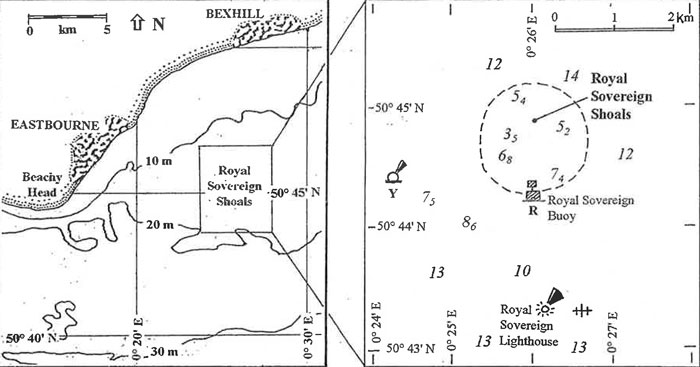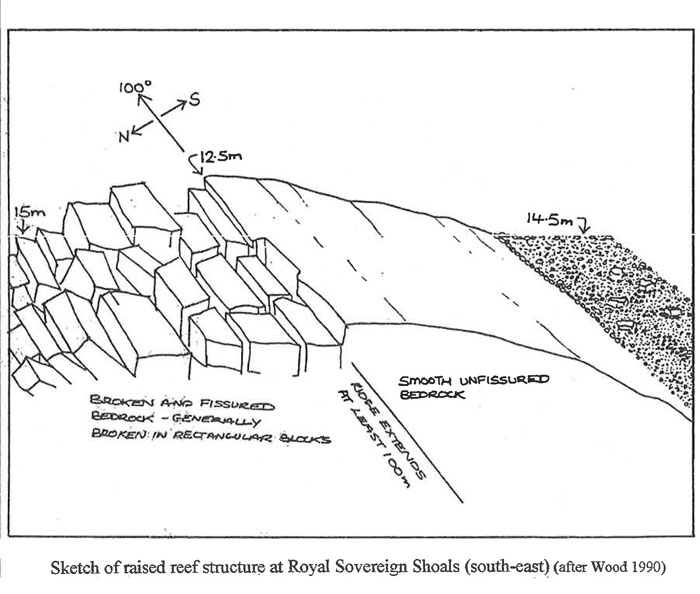SUSSEX MARINE SITES OF NATURE CONSERVATION IMPORTANCE
| Site: Royal Sovereign Shoals | Ref. No. 12 | ||||||
| Location: 12 km east of Beachy Head (the Royal Sovereign buoy marks the southern extent of the reef) | Other conservation designation?: No |
||||||
| Lat./Long. position of centre of site: 50° 44' 50" N 0° 26' 0" E |
OS grid ref. of centre of site: TV 720 960 |
Author: Robert Irving |
|||||
| Sea bed type: Extensive offshore sandstone reef (& part chalk reef). |
Depth range (below chart datum): 4-15 m |
Date identified: January 1996 |
|||||
Summary
The Royal Sovereign Shoals lie between 10-13 km ENE of Beachy Head, and 8-10 km off Langney Point, NE of Eastbourne. The reef covers an area of about 1 km2 and is marked by a buoy (the Royal Sovereign) at its southern end. Though most of the Shoals are of sandstone (probably Upper Greensand), outcrops of chalk occur in the north-west part. Other sandstone reef exposures occur to the west of this site, including Long Shoal, Horse of Willingdon and Elphick Tree. The reef rises from a surrounding sea bed of gravel, muddy sand and sand, and the area is sµbject to strong tidal currents which reach 2.6 knots at spring tides. The Shoals display a wide range of habitat types within a relatively small area and provide a good example of an offshore sandstone reef.
Biological Description
At the shallowest parts of the reef, sandstone bedrock slabs and flat-topped boulders are present. Kelp is absent and upward-facing rock surfaces have a covering of small foliose red algae with many small, silt amphipod tubes. Commonly seen animals include a variety of sponges, the white anemone Actinothoe sphyrodeta, sea squirts such as Clavelina lepadiformis and Botryllus schlosseri, the hydroid Nemertesia antennina, the erect bryozoans Alcyonidium diaphanum and Flustra foliacea and the starfish Asterias rubens. At depths of 7-14 m, rectangular slabs of sandstone bedrock may be encountered, with lengths of 2-3 m and vertical sides typicaly 40-50 cm high. In places, slabs are piled on one another with no consistent orientation, thus creating deep fissures, ovemangs and caves up to 2 m deep and 50 cm high. On under-slab surfaces the soft coral Alcyonium digitatum occurs together with colonies of the tubeworm Filograna implexa and small bushy bryozoans Bugula spp. The elephant's ear sponge Pachymatisma johnstonia may be present on the exposed edges of the slabs, an interesting find as this has not been recorded from Sussex chalk reefs and may be the most easterly record for this species. Similarly, this site may also provide the most easterly records in the Channel for the 'leafy' bryozoan Pentapora foliacea, the sea squirt Pycnoclavella aurilucens and the cuckoo wrasse Labrus mixtus. Large numbers of bib Trisopterus luscus and poor cod Trisopterus minutus frequent the area, together with goldsinny Ctenolabrus rupestris, ballan wrasse Labrus bergylta and, hiding in crevices, the tompot blenny Parablennius gattorugine. Where the edge of the reef meets the surrounding sediment (at 8-18 m depth), the bedrock is overlain by a covering of coarse sand and cobbles. The unstable nature of this substratum restricts the number of sessile species to those that can tolerate periodic inundation such as the 'chimney' sponges Ciocalypta penicillus and Polymastia mamillaris, and the anemones Cereus pedunculatus and Urticina felina.
References:Wood, C. 1990. Seasearch survey of sandstone reefs off Eastbourne, East Sussex A report to the Nature Conservancy Council from Marine Biological Consultants, Ltd., Ross-on-Wye |
|||||||
| SeasearchSandstoneReefsSurveyNums: 5A, 5B & 5C | |||||||
Site Location

Diagrammatic representation of site: Royal Sovereign Shoals


:Link to this page
Copyright Sussex Biodiversity Records Centre © 2025